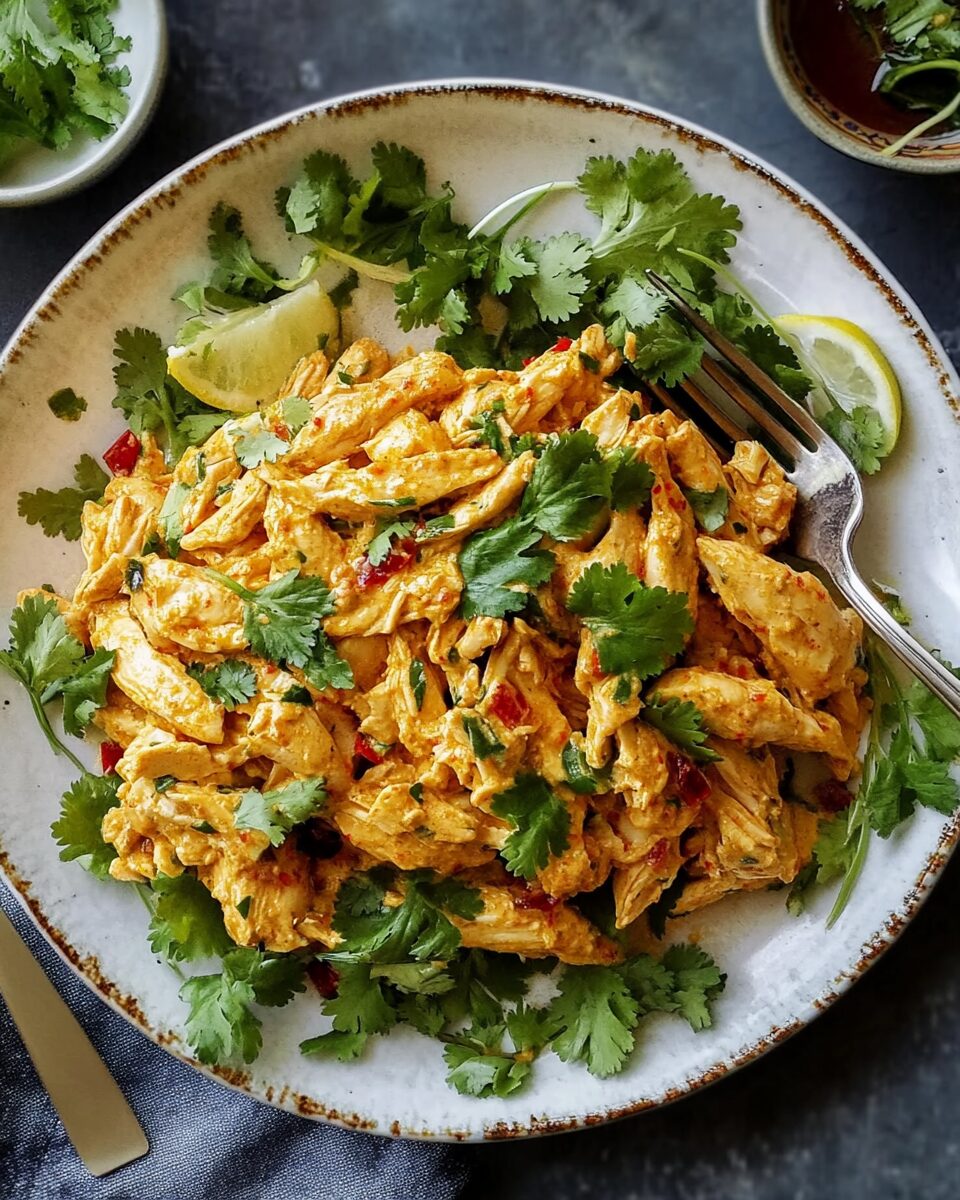Coronation Chicken is a delightful fusion of savory and sweet, blending the richness of curry with the fruity sweetness of apricots and the crunch of toasted almonds. This dish was first created for Queen Elizabeth’s coronation banquet, making it a meal truly fit for royalty. The creamy sauce, spiced with a hint of curry, envelops the tender poached chicken to create a flavorful and satisfying meal.
Perfect as a salad over crisp lettuce or as a filling for sandwiches, Coronation Chicken is a versatile dish that brings a unique flavor profile to any occasion. Whether you’re hosting a garden party or preparing a light summer meal, this recipe is sure to impress with its delicate balance of sweet, savory, and spicy flavors.
Full Recipe:
- 3 boneless, skinless chicken breasts (1 1/2 to 1 3/4 pounds)
- Kosher salt
- 1 tablespoon black peppercorns
- 2 bay leaves
- 1 tablespoon extra-virgin olive oil
- 1/2 medium white onion, diced
- 1 tablespoon tomato paste
- 1 tablespoon curry powder
- 1/4 cup red wine
- 2 tablespoons mango chutney
- Juice of 1/2 lemon (about 1 tablespoon)
- 1/2 cup mayonnaise
- 1/4 cup sour cream
- 1/4 cup chopped dried apricots
- 1/4 cup toasted sliced almonds
- 1/4 cup cilantro leaves, chopped
Directions:
- Begin by poaching the chicken. Season both sides of the chicken with salt. Place in a large pot with peppercorns and 1 bay leaf. Cover with water, bring to a boil, and simmer until chicken reaches 165°F, about 8-10 minutes. Cool the chicken, shred, and set aside.
- For the sauce, heat olive oil over medium heat. Add diced onion and sauté for 5 minutes. Stir in tomato paste and curry powder, cooking for another minute. Pour in red wine, water, mango chutney, lemon juice, and the second bay leaf, reducing for 5 minutes. Remove from heat and let cool.
- Mix mayonnaise and sour cream in a bowl. Add the cooled curry mixture and stir to combine.
- Toss the shredded chicken with apricots, almonds, and cilantro. Pour the sauce over the chicken mixture and gently combine until fully coated.
Prep Time: 15 minutes | Cooking Time: 10 minutes | Total Time: 55 minutes
Kcal: 315 kcal | Servings: 8 cups
The History and Origin of Coronation Chicken
Coronation Chicken is more than just a flavorful chicken salad; it’s a dish with royal origins, steeped in British culinary history. It was first served in 1953 during the coronation banquet of Queen Elizabeth II. Created by the renowned chefs Constance Spry and Rosemary Hume, this dish was designed to be elegant, but also accessible to the masses, combining the flavors of the British Empire’s diverse influences. The recipe represented the innovative use of readily available ingredients and incorporated the bright flavors of curry, which was becoming increasingly popular in Britain due to the country’s ties with India.
The creation of Coronation Chicken was a reflection of the time, blending familiar British ingredients with spices and flavors that celebrated Britain’s global connections. The dish also echoed the post-war period’s emphasis on utilizing what was available in creative ways, presenting a rich, flavorful, yet simple recipe that could be prepared for large gatherings. Since its introduction, Coronation Chicken has become a staple in British cuisine, often appearing in summer picnics, sandwich fillings, and buffet spreads.
Why Coronation Chicken Stands Out
Coronation Chicken holds a unique place in both historical and culinary contexts. It’s beloved not just for its rich flavors but also for its versatility and simplicity. Here’s why it continues to be a favorite:
- Historical Significance: Serving a dish with royal origins adds a sense of occasion to any meal. Coronation Chicken connects the modern kitchen to a pivotal moment in history, celebrating British culture and heritage with every bite.
- Flavor Complexity: The recipe masterfully balances a variety of flavors. The sweetness from dried apricots and mango chutney contrasts beautifully with the mild heat of curry powder. Meanwhile, the toasted almonds add a nutty crunch that enhances the texture, making it a multi-sensory experience.
- Versatility: One of the best aspects of Coronation Chicken is its versatility. It can be enjoyed in various forms, such as a sandwich filling, a salad topping, or even as a stand-alone side dish. This adaptability makes it a popular choice for picnics, lunchboxes, and even more formal dining settings.
- Ease of Preparation: Despite its elegant appearance and complex flavor profile, Coronation Chicken is surprisingly simple to prepare. With minimal cooking skills required, this dish is accessible to home cooks of all levels, making it a reliable go-to for both casual meals and more extravagant events.
- Meal Prep Friendly: This recipe is ideal for meal prepping, as the flavors only deepen over time. You can prepare it ahead of time and keep it refrigerated for a few days, making it perfect for quick lunches or dinners during the week.
- Healthy and Wholesome: While Coronation Chicken is indulgent in taste, it can be made healthier by using light mayonnaise or Greek yogurt as a base instead of full-fat ingredients. It’s naturally gluten-free, which makes it an inclusive dish suitable for many dietary preferences.
Creative Variations and Serving Ideas
While the traditional Coronation Chicken recipe is iconic, there are numerous ways to adapt it to suit different tastes or to create unique presentations. Here are some creative variations and serving suggestions:
- Coronation Chicken Sandwich: One of the most popular ways to enjoy this dish is as a sandwich filling. Serve it on whole grain bread, croissants, or even in a wrap. Adding lettuce, cucumber, or avocado can provide additional freshness and texture.
- Coronation Chicken Salad: For a lighter, carb-free option, serve Coronation Chicken over a bed of crisp lettuce or mixed greens. You can add fresh herbs, cucumbers, or cherry tomatoes for a refreshing contrast to the rich curry sauce.
- Baked Coronation Chicken: For a hot twist, you can stuff the Coronation Chicken mixture into hollowed-out bell peppers or large mushrooms, then bake until everything is heated through and golden. This version makes for a stunning appetizer or dinner option.
- Vegan Coronation “Chicken”: By substituting the chicken with plant-based alternatives like jackfruit, chickpeas, or tofu, you can create a vegan version of the dish that retains the same beloved flavors.
- Coronation Chicken Pasta Salad: Mix the Coronation Chicken with cooked pasta, such as fusilli or penne, for a hearty and filling pasta salad. This variation is great for potlucks and family gatherings.
- Picnic Perfect: Coronation Chicken is a favorite dish for picnics. Its robust flavors hold up well at room temperature, and it pairs perfectly with cold sides like potato salad, coleslaw, or fruit salad.
- Coronation Chicken Tart: For a unique twist, you can use the Coronation Chicken filling in a savory tart or quiche, baked in a pastry shell. This variation is great for brunch or a light dinner.
- Coronation Chicken Canapés: For a party-friendly version, serve small spoonfuls of Coronation Chicken atop crackers, crostini, or cucumber rounds. Garnish with cilantro or a sliver of dried apricot for an elegant touch.
Cultural Importance and Modern Appeal
Coronation Chicken remains an enduring part of British cuisine, symbolizing both tradition and the ever-evolving nature of food. In contemporary cooking, the dish continues to evolve with modern preferences for lighter, healthier meals. Many cooks now use Greek yogurt in place of mayonnaise or add extra vegetables to increase its nutritional value. Despite these changes, the essence of the dish—a harmonious blend of sweet, savory, and spicy flavors—remains unchanged.
The curry flavor, once a bold and somewhat unusual choice for a British dish, is now a familiar and beloved part of British cuisine, reflecting the diverse culinary influences that have shaped the nation’s palate. Coronation Chicken is a dish that embodies the blending of cultures, history, and taste, making it as relevant today as it was during the 1953 coronation.
Nutritional Insights and Modifications
Though Coronation Chicken is traditionally made with rich ingredients like mayonnaise and sour cream, it can be easily modified for various dietary needs. For those looking to reduce the calorie count, using light or low-fat alternatives for the sauce base is a simple and effective option. Additionally, the use of dried apricots and almonds adds not only flavor but also nutritional benefits, such as fiber, vitamins, and healthy fats.
For those with dietary restrictions, the dish is naturally gluten-free, which makes it a wonderful option for anyone avoiding gluten. It can also be made dairy-free by using dairy-free yogurt or mayonnaise substitutes, catering to lactose-intolerant or vegan individuals.
Conclusion
Coronation Chicken is a dish with a rich history, versatile application, and complex flavor profile that continues to captivate home cooks and food lovers alike. Whether you’re looking for a simple salad, a sandwich filling, or an impressive addition to your next gathering, Coronation Chicken delivers a unique and delightful experience. The harmony of sweet and savory, combined with its historical significance, ensures that this recipe will remain a beloved favorite for generations to come.
As the recipe continues to evolve with modern twists, its essence—a celebration of flavor and innovation—endures. Whether you’re a novice in the kitchen or a seasoned cook, Coronation Chicken is a must-try recipe that offers both nostalgia and contemporary appeal.





